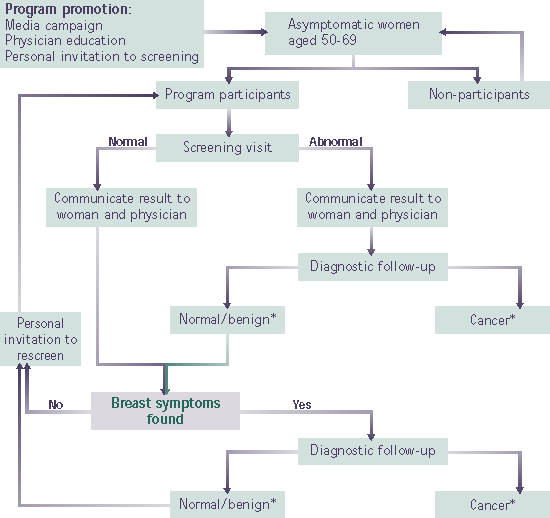Common menu bar links
Institutional links
Diseases & Conditions
Health & Safety
Research & Statistics
Agency Information
Search Box
E-mail this page
The Screening Process
The process that an organized breast cancer screening program under-goes to reach its target population for screening can be described in three stages: identification and invitation of the target population; provision of the screening examination; and, if an abnormality is detected, further investigation. Figure 2 illustrates the pathway in more detail.
Figure 2
Pathway of a breast cancer screening program

* Breast screening programs obtain final diagnoses
from sources such as physicians, pathology reports
and cancer registries.
|
Organized screening programs began in British Columbia in 1988 and have since expanded to include all provinces, the Yukon and the Northwest Territories. |
Women of the target age are recruited to the screening
program through either a letter of invitation, a physician referral, or
self-referral. At the screening facility, which may be a mobile unit or
a fixed site, women receive two-view mammography of each breast. In addition
to mammographic screening, women attending programs in Ontario, Manitoba,
Nova Scotia, Prince Edward Island, and Newfoundland receive a clinical
breast examination performed by a trained health professional while the
remaining programs encourage women attending screening to obtain regular
clinical breast examination outside of the program from their family physicians
(Table 1). All programs provide screening results
to both the woman and her physician. If the screening result is normal,
women who are still eligible are recalled by letter of invitation for
another routine screen. This generally occurs after 2 years, although
a minority of women are recalled annually based on age, mammographic results,
family history, or other factors that vary across programs. Women with
an abnormal screening result are informed, along with their family physician,
of the need for further assessment. Generally, the diagnostic follow-up
is coordinated by the woman’s physician and is completed when a final
diagnosis of either cancer or normal/benign is reached. Program participants
are advised that although mammography is highly effective in detecting
breast cancers early, there is a possibility that some cancers are undetectable
by mammography. A small number of women may develop symptoms in the interval
before their next screening visit and are encouraged to consult their
physician as soon as possible.
|
Table 1 |
||||
|
Program |
Program |
Mammography Interval |
Clinical Breast |
Target Population Age |
|
British Columbia* |
1988 |
Biennial |
No |
50-74 |
|
Yukon |
1990 |
Biennial |
No |
50-69 |
|
Northwest Territories |
1994 |
Biennial |
No |
50-69 |
|
Alberta |
1990 |
Biennial |
No |
50-69 |
|
Saskatchewan |
1990 |
Biennial |
No |
50-69 |
|
Manitoba |
1995 |
Biennial |
Nurse or technologist |
50-69 |
|
Ontario |
1990 |
Biennial |
Nurse |
50-69 |
|
Quebec |
1998 |
Biennial |
No |
50-69 |
|
New Brunswick |
1995 |
Biennial |
No |
50-69 |
|
Nova Scotia |
1991 |
Biennial |
Technologist |
50-69 |
|
Prince Edward Island |
1998 |
Biennial |
Technologist |
50-69 |
|
Newfoundland |
1996 |
Biennial |
Nurse |
50-69 |
|
* Until mid-1997, British Columbia had annual recall frequency (mammography interval) for all women aged 40 and over. |
||||
|
Table 2 |
||||
|
Program |
Program Practices |
|||
|
Age Group |
Actively Recruit |
Accept |
Recall |
|
|
British Columbia* |
40-49 |
|
|
Annual |
|
70-74
|
|
|
Biennial
|
|
|
75-79
|
|
|
Biennial
|
|
|
80+
|
|
|
|
|
|
Yukon |
40-49 |
|
|
|
|
70+
|
|
|
|
|
|
Northwest Territories |
40-49 |
|
|
Annual |
|
70+
|
|
|
Biennial
|
|
|
Alberta |
40-49 |
|
|
Biennial |
|
70-74
|
|
|
Biennial
|
|
|
75+
|
|
|
|
|
|
Saskatchewan |
40-49 |
|
|
N/A |
|
70+
|
|
|
Biennial
|
|
|
Manitoba** |
40-49 |
|
|
Biennial |
|
70+
|
|
|
|
|
|
Ontario |
40-49 |
|
|
N/A |
|
70+
|
|
|
Biennial
|
|
|
Quebec |
40-49 |
|
|
|
|
70+
|
|
|
|
|
|
New Brunswick |
40-49 |
|
|
|
|
70+
|
|
|
|
|
|
Nova Scotia |
40-49 |
|
|
Annual |
|
70+
|
|
|
Biennial
|
|
|
Prince Edward Island |
40-49 |
|
|
Annual |
|
70-74
|
|
|
Biennial
|
|
|
Newfoundland |
40-49 |
|
|
N/A |
|
70-74
|
|
|
Biennial
|
|
|
* Until mid-1997, British Columbia had annual recall frequency
for all women aged 40 and over. |
||||
[Previous] [Table of Contents] [Next]
